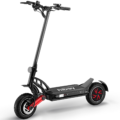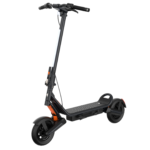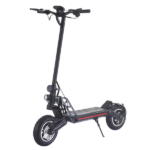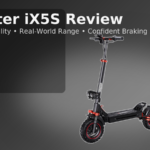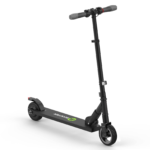- Home
- Scooters
- Electric Scooters
- Hiboy U2 Pro
Hiboy U2 Pro




- Battery Range: 34 mi (55 km)
- Top Speed: 22 mph (35 km/h)
- Motor Power: 500 W nominal
- Weight Capacity: 265 lb (120 kg)
- Charging Time: ~6–7 h
- Scooter Weight: 55.0 lb (24.9 kg)
PROS
- Extra range and hill power
- Seated comfort with 14″ tires
- Confident braking with e-assist
- Bright lighting and reflectors
- Familiar fold and storage
CONS
- Heavier than stand-up commuters
- Pneumatic tires need pressure care
- Larger folded footprint
- Top speed capped for safety


Overview: Hiboy U2 Pro — Comfort-Forward, Daily-Ready Commuter
The Hiboy U2 Pro is built for riders who value calm control, everyday comfort, and low-drama upkeep. To begin with, it favors predictable acceleration over twitchy surges, and it pairs that with a stable chassis that feels composed on real city pavement. Moreover, the cockpit is clean and intuitive, so you glance, read, and go without menu-digging. As a result, the U2 Pro invites weekday commuting, after-work errands, and weekend loops without fuss.
In practice, power delivery is smooth and linear at city speeds. Consequently, starts feel composed at intersections, and mid-block merges happen without abrupt jolts. Meanwhile, braking is reassuring: electronic assist trims speed progressively, while the mechanical hardware provides firm, familiar bite when you ask for more. Additionally, bright lighting and reflective accents raise conspicuity at dusk, and the bell makes passing on shared paths polite rather than startling.
For ownership, the formula is intentionally simple. Charge regularly, store indoors, and give the folding latch a quick monthly check. Furthermore, keep tire pressures on point, wipe grit after wet rides, and you’ll preserve range, quiet, and confidence. Ultimately, read the specifications once, match the scooter to your height and local rules, then ride: the U2 Pro is a steady, comfort-forward way to move through the week.
Who the Hiboy U2 Pro Is For
First and foremost, commuters who want reliable A-to-B with minimal tinkering. Because the controls are straightforward and the ride is composed, you can focus on traffic, not toggles.
Secondly, riders returning after a break who prefer smooth, confidence-building behavior. Since acceleration ramps gently and steering tracks predictably, the learning curve feels short.
Third, neighborhood and campus riders who mix street, path, and parking-lot shortcuts. Accordingly, the scooter’s stable geometry and practical lighting make multi-surface trips less stressful.
Finally, pragmatic owners who value cost control. Because routine care is simple, you spend more time riding and less time wrenching—consequently, total ownership stays mellow.
Design Philosophy: Calm Control Over Chaos
The U2 Pro’s design emphasizes stability, comfort, and clarity. In particular, the deck height and stance support relaxed balance at low speeds, while the bar reach keeps wrists neutral and shoulders down. Additionally, the display is easy to read in daylight, and the control layout is obvious at a glance. Together, these choices reduce cognitive load, so you monitor the route instead of the dash.
Notably, cable routing is tidy to minimize snags; the kickstand footprint is broad enough to resist tip-overs; and the fold mechanism aims for confident lockup rather than a rattly quick-fold. Therefore, the scooter feels composed not only while rolling but also when parked, carried, or stowed.
Comfort & Ergonomics: Posture That Lasts
Comfort drives consistency. Because the bar height, grip diameter, and lever angles skew toward neutral ergonomics, long rides feel less fatiguing. Moreover, a roomy deck lets you vary foot placement: forward for cruising, centered for maneuvering, and back for leverage under braking. As a result, you can reset posture mid-ride and arrive fresher.
If needed, micro-adjust bar rotation a few degrees. Often, that tiny change shifts pressure from wrists to palms. Likewise, set lever angle so your forearm and wrist align in a straight line. Consequently, you maintain light hands and precise inputs even on rougher blocks.
Urban Performance: Smooth Where It Matters
Urban riding rewards predictability over peak numbers. Accordingly, the U2 Pro’s throttle mapping aims for smooth, repeatable launches. When the light turns, you roll on, settle into pace, and hold a tidy line. On short rises, torque keeps momentum; on longer climbs, speed tapers gradually rather than dropping off a cliff. Therefore, you plan calmly, pick clean paths, and conserve energy.
Meanwhile, rider weight, cargo, temperature, and wind still influence feel. To compensate, keep tires properly inflated, secure bags centrally, and avoid gusty open corridors when an alternative street offers shelter. Consequently, the ride remains even-keeled day to day.
Braking & Modulation: Confidence on Tap
Safe stops are about sequence and smoothness. Therefore, practice this rhythm: throttle off, eyes up, then brake. By lifting first, you remove drive; subsequently, electronic assist begins deceleration, and mechanical brakes finish the job with firm control. In dry conditions, bias slightly toward the front for shorter, straighter halts. In the wet, extend following distance and add pressure progressively. As a result, you avoid skids and keep the chassis settled.
Pro tip: with cargo aboard, start braking earlier. Because weight shifts rearward, the front tire’s workload rises. Consequently, gentle initial pressure produces more grip than a sudden squeeze.
Lighting & Visibility: Be Seen, Then Be Understood
Seeing is critical; being seen is non-negotiable. Accordingly, the U2 Pro’s headlight brightens your path and outlines your presence to drivers. Additionally, the tail/brake light and reflectors boost conspicuity from multiple angles. Nevertheless, consider upgrades for darker routes: a bar-mounted secondary light aimed slightly down, a helmet flasher at eye level, and reflective ankle bands that create motion cues motorists notice instantly. Collectively, these touches transform dusk rides from edgy to easy.
Tires, Chassis & Ride Quality: Tuned for the City
City surfaces vary block to block. Therefore, compliance matters more than catalog superlatives. Whether you’re on pneumatic or puncture-resistant rubber (model dependent), correct PSI is your first suspension setting. If under-inflated, steering dulls and energy sags; if over-inflated, chatter increases and grip shrinks. Consequently, aim for a pressure that resists pinch while muting vibration. Meanwhile, check tread and sidewalls monthly; as soon as cuts grow or cords show, replace before the next big week.
Likewise, keep fasteners snug and the fold joint tight. Because micro-play multiplies vibration, a quarter-turn on the correct bolt can restore quiet and sharpen steering feel.
Battery, Range & Charging: Practical Habits That Pay
Range is the sum of speed, stops, slope, temperature, and tires. Nevertheless, consistent habits stretch miles:
- Cruise steadily. Consequently, you avoid wasteful power spikes.
- Plan routes. Sometimes, a slightly longer path with fewer lights saves more energy than a stop-and-go shortcut.
- Keep tires topped. Therefore, rolling resistance falls and range rises.
- Charge indoors. Because batteries prefer moderate temps, cellar-cold and attic-hot shorten life.
- Store at 50–70% when pausing for weeks. As a result, cell health stays balanced.
Before charging, let a heat-soaked battery cool to room temperature. Afterward, unplug at full and coil the cable to prevent strain. Ultimately, these small rituals deliver reliable weekends and calmer Monday mornings.
Portability & Storage: Folding Without the Fiddle
Folding should be secure first, quick second. Consequently, get in the habit of verifying latch engagement every time. If you hear a new rattle, stop and recheck; often, it’s a simple alignment click. For hallway storage, park nose-in with the rear against a wall. Meanwhile, a small floor mat under the stand protects floors and catches road grit. In vehicles, use a soft strap to prevent the scooter from sliding during turns; therefore, the hinge and display remain stress-free.
Weather Readiness: Sensible Margins, Year-Round
Rain, heat, and cold all ask for adjusted expectations. In light rain, ride smoother, extend stopping distance, and avoid painted lines and metal grates. After the ride, wipe moisture from the deck, latch, and connectors. In summer, don’t bake the scooter in a parked car; instead, charge indoors. In winter, expect reduced range; therefore, plan conservative loops or carry a workplace charger if policy allows. Ultimately, weather-aware pacing keeps rides relaxed and components happy.
Setup & First-Week Tuning: Start Right, Stay Right
On day one, give yourself 30 minutes:
- Torque sweep on stem, bar clamp, brake mounts, and rack points (if equipped).
- PSI set to your target range; then note it on your phone.
- Brake bed-in: accelerate to moderate speed; apply firm, smooth stops 8–10 times.
- Cockpit fit: rotate bars and set levers for straight wrists; afterward, do a short shakedown loop and tweak again.
- Cable clearance: turn bars end-to-end to confirm nothing snags.
Because you documented these baselines, future checks become quick, and any drift becomes obvious.
Maintenance: Little Things, Big Payoff
Reliability is a habit, not a mystery. Accordingly, adopt this cadence:
- Weekly: PSI check, quick lever feel test, wipe dust and grit.
- Monthly: fastener sweep, pad wear glance, latch inspection.
- Quarterly: tire condition review, pivot lube where appropriate, charger cable inspection.
If a new noise appears, chase it immediately. Usually, the fix is simple—a loose accessory bolt, a misaligned caliper, or a dry hinge. Consequently, you prevent small annoyances from becoming real repairs.
Safety & Etiquette: Ride Like a Neighbor, Be Treated Like One
Because predictability earns trust, hold a steady line, signal early, and make eye contact at intersections. On shared paths, keep right, announce passes with the bell, and slow near dogs, toddlers, and playgrounds. In traffic, choose visibility over stealth: lights on, reflective accents, and calm lane choices. Therefore, your presence is both seen and understood.
Accessories That Add Value (Not Weight)
Choose deliberately, and each add-on solves a real problem:
- Phone mount for glanceable navigation; meanwhile, keep notifications off.
- Compact lock sized for quick coffee stops within sight.
- Clip-on headlight for unlit connectors; in contrast, bright city grids may need only the built-in.
- Small frame bag for strap, tool, and a spare valve cap.
- Reflective stickers on the rear fender and deck edges for dusk depth.
By avoiding gadget creep, you preserve range and keep the scooter tidy.
Efficiency & Cost: Replace Short Car Trips, Reclaim Time
Short urban drives are expensive in minutes and money. Therefore, replace them. Bundle errands, favor low-stop routes, and park by the bike rack, not the curb meter. Consequently, you skip fuel stops, idling, and parking hunts. Psychologically, you also simplify the “Should I go now?” moment—and that convenience drives real-world usage.
Handling Tips: Smooth Inputs, Stable Outcomes
- Steer with the eyes. As soon as you look where you want to go, the bars follow.
- Lean the body, not just the bars, for cleaner arcs.
- Feather the throttle through turns; therefore, mid-corner bumps feel less dramatic.
- Stand briefly on rough patches to unload the knees; afterward, sit back into your neutral stance.
- With cargo, keep mass low and centered; consequently, the scooter remains composed.
Troubleshooting: Quick Wins, Calm Fixes
If the scooter won’t wake, confirm battery level and hold the power button for a full second. Sometimes, a quick tap isn’t enough.
If acceleration feels flat, check PSI first, then verify you’re not resting a foot on the rear brake. Often, posture alone restores pep.
If a rattle appears, inspect the latch and accessory mounts. Usually, a quarter-turn resolves it.
If the display seems dim, shade it with your hand to confirm; then, adjust angle slightly to cut glare.
Pros & Cons at a Glance
What you’ll love
- Smooth, predictable power that calms city starts
- Stable chassis and ergonomic cockpit for longer comfort
- Clear lighting and easy upgrade path for darker routes
- Low-drama maintenance with simple weekly checks
- Practical portability and tidy storage habits
Trade-offs to consider
- Tuned for composure rather than explosive sprints
- Range varies with temperature, terrain, and PSI (plan accordingly)
- Fold speed is secondary to fold security by design
- Firm tire feel at higher PSI on very rough blocks
A 10-Step First-Week Routine (Confidence Builder)
- Helmet check and strap test—every ride.
- PSI confirm before Monday and Thursday commutes.
- Bar/lever micro-tune until wrists feel neutral.
- Three practice stops in a quiet lot to refresh feel.
- Route pick that avoids the worst stop-and-go.
- Lights on 30 minutes before sunset, no exceptions.
- Bell etiquette on shared paths—announce, pass, thank.
- Post-ride wipe after rain or dusty detours.
- Cable glance at the hinge and bar sweep once mid-week.
- Sunday sweep: fasteners, latch, pads, and charger cable.
Because this checklist is short, you actually do it; therefore, the scooter stays quiet, safe, and ready.
Final Take: Quiet Competence, Every Single Day
The Hiboy U2 Pro prioritizes comfort, clarity, and composure—qualities that matter more in real traffic than spec-sheet fireworks. Because acceleration is smooth and controls are intuitive, you ride with a cool head. Since the chassis is stable and the lighting is thoughtful, dusk commutes feel straightforward rather than tense. Meanwhile, simple maintenance habits keep performance consistent month after month.
Ultimately, if you want a commuter that trades drama for dependability—and style points for stress reduction—the U2 Pro fits. Set the cockpit, set the tires, and set your route. Then, enjoy the calm cadence of everyday rides that just work.
Specifications
General
| Model The Model specifies the exact version or name of the scooter. It helps identify its unique design, features, and specifications within the manufacturer’s product line. Knowing the model makes it easier to compare options, find compatible accessories, or look up support information. | U2 Pro |
| Brand The Brand identifies the manufacturer or company that designs and produces the scooter. A trusted brand is a sign of quality, reliability, and good customer support. Well-known brands often have higher standards for safety, performance, and after-sales service, giving you more confidence in your purchase. | Hiboy |
| Release Date The Release Date indicates when the scooter model was officially launched on the market. This helps you know how current the design, technology, and features are. A newer release date often means updated components, improved performance, and the latest safety or smart features. | 17 November 2025 |
| Recommended Age Recommended Age indicates the minimum age range that the scooter is designed for, based on safety, size, and ease of use. Following the recommended age helps ensure that riders can handle the scooter’s speed, weight, and controls comfortably and safely. Always check local laws and use protective gear, especially for younger riders. | Recommended 16+ |
Performance & Power
| Motor Power (Wattage) What it means: The motor power, measured in watts (W), shows how strong the scooter’s electric motor is. Why it matters: Higher wattage usually means better acceleration, more torque, and improved performance on hills or rough terrain. For example, a 250W motor is good for flat city roads and light riders, while a 500W or 1000W motor provides more power for faster speeds or climbing steep inclines. | 500 W nominal (700 W peak) |
| Top Speed The Top Speed indicates the maximum speed that the scooter can reach under optimal conditions. It’s usually measured on level ground with a fully charged battery and an average rider weight. A higher top speed allows you to travel longer distances faster, but always ensure you ride within legal speed limits and your personal comfort zone for safety. | 22 mph (35 km/h) |
| Battery Capacity Battery Capacity refers to the total amount of energy the scooter’s battery can store, usually measured in ampere-hours (Ah) or watt-hours (Wh). A higher battery capacity means you can ride longer distances on a single charge, reducing the need for frequent recharging. Keep in mind that actual range can vary depending on rider weight, terrain, speed, and weather conditions. | 48 V 12 Ah |
| Estimated Range per Charge The Estimated Range per Charge indicates the average distance the scooter can travel on a single full battery charge. This range is calculated under optimal conditions, such as flat terrain, moderate speed, and average rider weight. Real-world range may vary depending on riding style, terrain, weather, and load. A longer range means fewer recharges and greater freedom for longer trips. | Up to 34 mi (55 km) |
| Hill Climb Ability Hill Climb Ability describes the maximum incline or slope that the scooter can handle while maintaining stable performance. It’s typically expressed as a percentage or in degrees. A higher hill climb rating means the scooter can tackle steeper hills without losing too much speed or power. Actual climbing performance may vary based on rider weight, battery charge, and terrain conditions. | Up to 20° grades |
| Drive System The Drive System refers to how power from the motor is delivered to the wheels. Electric scooters typically use either a hub motor (directly integrated into the wheel) or a chain/belt drive system. A high-quality drive system ensures smooth acceleration, efficient power transfer, and low maintenance. The choice of drive system affects performance, noise level, and overall ride experience. | Rear hub motor (RWD) |
Charging & Electrical
| Charging Time Charging Time indicates how long it takes to fully recharge the scooter’s battery from empty to 100% using the standard charger provided. Faster charging means less downtime and more time on the road. Actual charging time may vary slightly depending on battery capacity, charger output, and environmental conditions. | Approx. 6–7 hours |
| Battery Type Battery Type refers to the specific technology used in the scooter’s battery, which affects performance, lifespan, weight, and charging time. Most modern electric scooters use high-quality lithium-ion (Li-ion) batteries because they offer a good balance of energy density, durability, and low maintenance. A reliable battery type ensures consistent power delivery and longer riding ranges. | Li-ion with Smart BMS |
| Removable Battery A Removable Battery means the battery pack can be easily detached from the scooter for convenient charging and replacement. This feature allows you to charge the battery separately, swap it with a spare for extended range, or securely store it indoors in extreme weather. Removable batteries add flexibility and make it easier to keep your scooter powered up wherever you are. | No external fast charge |
| Regenerative Braking Regenerative Braking is an energy-saving feature that converts some of the energy normally lost during braking back into battery power. When you slow down or brake, the motor works in reverse to generate electricity, which helps extend the scooter’s range and improves overall efficiency. This system also reduces wear on traditional brake components, leading to lower maintenance over time. | Regenerative electronic assist |
| Lighting Lighting refers to the built-in front and rear lights that enhance visibility and safety when riding in low-light conditions or at night. Good lighting helps you see the road ahead and ensures that other road users can see you. Many scooters include LED headlights, taillights, and sometimes brake lights or side reflectors for added safety and compliance with local traffic regulations. | Headlight + tail/brake + reflectors |
Build & Dimensions
| Scooter Weight Scooter Weight refers to the total weight of the scooter when fully assembled, including the battery. This affects how easy it is to carry, lift, and store the scooter when not in use. A lighter scooter is more portable and convenient for commuting, especially if you need to carry it upstairs or onto public transport. Keep in mind that a sturdy frame and quality components may add to the weight but also contribute to better durability and ride stability. | 55.0 lb (24.9 kg) |
| Maximum Rider Weight Maximum Rider Weight indicates the highest rider weight that the scooter is designed to safely support while maintaining optimal performance and stability. Staying within this limit helps ensure reliable acceleration, braking, and climbing ability, and it protects the frame, suspension, and motor from excessive strain. Exceeding the recommended limit may reduce performance and increase wear on components. | 265 lb (120 kg) |
| Deck Size Deck Size refers to the dimensions of the scooter’s standing platform. A wider and longer deck provides more foot space, allowing you to stand comfortably and adjust your stance while riding. A well-sized deck improves balance and stability, especially on longer rides or at higher speeds. Compact decks, on the other hand, help keep the scooter lightweight and portable. | Seated geometry; stable wheelbase |
| Handlebar Height Handlebar Height refers to the distance from the deck to the handlebars, which affects your riding posture and comfort. An appropriate handlebar height helps you maintain good balance, reduces strain on your back and arms, and makes steering more comfortable. Some scooters have adjustable handlebars to fit riders of different heights, while others have a fixed height for a streamlined design. | Comfort bar height |
| Folding Mechanism The Folding Mechanism describes how easily and securely the scooter can be folded for carrying and storage. A well-designed folding system lets you quickly collapse the scooter into a compact size, making it convenient to transport on public transit, store under a desk, or fit into a car trunk. Look for sturdy latches and safety locks to ensure the scooter stays firmly in place when folded or unfolded. | Quick folding stem |
| Dimensions Folded Dimensions indicate the size of the scooter when it’s fully folded. This measurement shows how much space the scooter will take up when stored or carried, making it easier to check if it will fit in your car trunk, under a desk, or in a closet. Compact folded dimensions are ideal for commuters who need to bring their scooter on public transport or store it in tight spaces. | 51.0 × 23.0 × 25.0 in (folded) |
| Material Material refers to the primary construction materials used for the scooter’s frame and key components. High-quality materials like aircraft-grade aluminum, reinforced steel, or durable composites provide strength, stability, and a lighter overall weight. A sturdy material ensures the scooter can handle daily wear and tear while maintaining safety and performance. | Steel/aluminum mix |
Safety & Control
| Brake Type(s) Brake Type(s) describe the braking systems the scooter uses to help you slow down or stop safely. Common brake types include mechanical brakes (like drum or disc brakes), electronic brakes, and foot brakes. Many scooters combine multiple braking systems for added safety and shorter stopping distances. The type and quality of brakes affect your control, especially when riding at higher speeds or on slopes. | Rear drum + electronic assist |
| Suspension Suspension refers to the system that absorbs shocks and vibrations while riding, providing a smoother and more comfortable ride over uneven or rough surfaces. Scooters may have front suspension, rear suspension, or dual suspension for better shock absorption and stability. Good suspension helps reduce rider fatigue and improves control, especially when riding on bumpy roads or off-road paths. | Front fork + rear spring |
| Tire Type Tire Type refers to the kind of tires the scooter uses, which directly affects ride comfort, traction, and maintenance. Common types include solid (airless) tires, pneumatic (air-filled) tires, or hybrid options. Pneumatic tires offer better shock absorption and a smoother ride on rough surfaces, while solid tires are puncture-proof and require less upkeep. The right tire type helps ensure safe handling and a comfortable ride in different conditions. | Pneumatic street |
| Tire Size Tire Size indicates the diameter and width of the scooter’s tires, which affect ride comfort, stability, and how well the scooter handles different terrains. Larger tires generally offer better shock absorption and a smoother ride over bumps and rough surfaces, while smaller tires keep the scooter lighter and more portable. Choosing the right tire size helps ensure a balance between agility and comfort. | 14-inch |
| Kickstand The Kickstand is a built-in stand that allows you to park your scooter upright when it’s not in use. A sturdy kickstand keeps the scooter stable and prevents it from tipping over, protecting it from scratches and damage. It also makes storing and accessing your scooter more convenient, whether you’re at home, work, or on the go. | Side kickstand |
| Water Resistance Rating Water Resistance Rating indicates how well the scooter is protected against water and moisture, usually shown as an IP (Ingress Protection) rating. This rating helps you understand whether the scooter can handle light rain, splashes, or wet roads without damage. While most scooters are not fully waterproof, a good water resistance rating adds peace of mind when riding in changing weather conditions. Always avoid deep puddles or submerging the scooter to protect its electrical components. | IPX4 body |
Features & Extras
| Display/Console The Display (or Console) shows important real-time information about your ride, helping you monitor your scooter’s status at a glance. Typical displays show speed, battery level, distance traveled, and riding mode. Some models also include additional features like Bluetooth connectivity, app integration, or backlighting for better visibility at night. A clear and easy-to-read display enhances safety and convenience on every trip. | LED dashboard |
| Ride Modes Ride Modes refer to the different speed and power settings you can choose to match your riding style or road conditions. Common modes include eco for maximum range and energy efficiency, standard for everyday balance, and sport or turbo for higher speed and stronger acceleration. Switching between ride modes allows you to customize performance, conserve battery, and ride safely in various environments. | Eco, Drive, Sport + Cruise |
| Smart App Connectivity Smart App Connectivity lets you pair your scooter with a dedicated mobile app via Bluetooth. Using the app, you can monitor real-time ride stats like speed, battery level, and range, adjust settings such as ride modes or cruise control, lock the scooter for added security, and sometimes receive firmware updates. This feature adds convenience and allows you to personalize your riding experience right from your smartphone. | Bluetooth app connectivity |
| Anti-Theft System The Anti-Theft System helps protect your scooter from unauthorized use or theft. This feature can include built-in alarms, electronic motor locks, GPS tracking, or remote locking through a mobile app. A good anti-theft system provides peace of mind when parking your scooter in public spaces, adding an extra layer of security to safeguard your investment. | Electronic lock via app |
| Cruise Control Cruise Control allows you to maintain a steady speed without continuously holding the throttle. This feature makes longer rides more comfortable by reducing hand fatigue and providing a smoother, more relaxed riding experience — especially on flat, open roads or bike lanes. For safety, cruise control can usually be easily activated or deactivated while riding. | Yes (cruise control) |
| Accessories Included Accessories Included lists the additional items that come with the scooter to enhance your riding experience and convenience. Common accessories may include a charger, kickstand, bell, lights, phone holder, or carrying strap. These extras add value by making your scooter safer, easier to use, and ready to ride straight out of the box. | Bell, reflectors, charger |
Warranty & Compliance
| Warranty Period The Warranty Period indicates how long the manufacturer guarantees the scooter against defects in materials and workmanship under normal use. A good warranty provides peace of mind, showing the brand’s confidence in its product quality. Always check what parts are covered, such as the frame, battery, and motor, and follow the maintenance guidelines to keep your warranty valid. | Typically 12 months (regional) |
| Certifications Certifications confirm that the scooter meets specific safety, quality, and environmental standards set by recognized organizations or regulatory bodies. Common certifications may include CE, RoHS, UL, or other local compliance marks, depending on your region. These certifications ensure that the scooter is manufactured to high standards and is safe and legal to use in your country. | Local e-scooter compliance |
Price Comparison




